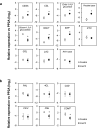Nitrogen deficiency results in changes to cell wall composition of sorghum seedlings
- PMID: 34857783
- PMCID: PMC8640004
- DOI: 10.1038/s41598-021-02570-y
Nitrogen deficiency results in changes to cell wall composition of sorghum seedlings
Abstract
Sorghum [Sorghum bicolor (L.) Moench] has been gaining attention as a feedstock for biomass energy production. While it is obvious that nitrogen (N) supply significantly affects sorghum growth and biomass accumulation, our knowledge is still limited regarding the effect of N on the biomass quality of sorghum, such as the contents and structures of lignin and other cell wall components. Therefore, in this study, we investigated the effects of N supply on the structure and composition of sorghum cell walls. The cell walls of hydroponically cultured sorghum seedlings grown under sufficient or deficient N conditions were analyzed using chemical, two-dimensional nuclear magnetic resonance, gene expression, and immunohistochemical methods. We found that the level of N supply considerably affected the cell wall structure and composition of sorghum seedlings. Limitation of N led to a decrease in the syringyl/guaiacyl lignin unit ratio and an increase in the amount and alteration of tissue distribution of several hemicelluloses, including mixed linkage (1 → 3), (1 → 4)-β-D-glucan, and arabinoxylan. At least some of these cell wall alterations could be associated with changes in gene expression. Nitrogen status is thus one of the factors affecting the cell wall properties of sorghum seedlings.
© 2021. The Author(s).
Conflict of interest statement
The authors declare no competing interests.
Figures






References
-
- World Bioenergy Association. Global Bioenergy Statistics 2020 (2020).
-
- Morrison, A. J. Global demand projections for renewable energy resources. In IEEE Canada Electrical Power Conference EPC 2007 537–542. 10.1109/EPC.2007.4520389 (2007).
-
- Somegowda, V. K. et al. Evaluation of fodder yield and fodder quality in sorghum and its interaction with grain yield under different water availability regimes. Curr. Plant Biol.25. 10.0191 (2021).
-
- Reddy N, Yang Y. Fibers from sorghum stems and leaves. In: Reddy N, Yang Y, editors. Innovative Biofibers from Renewable Resources. Berlin: Springer; 2015. pp. 11–12.
Publication types
MeSH terms
Substances
LinkOut - more resources
Full Text Sources

